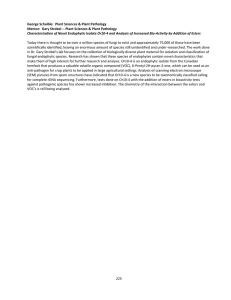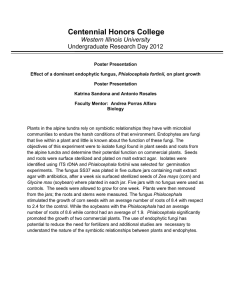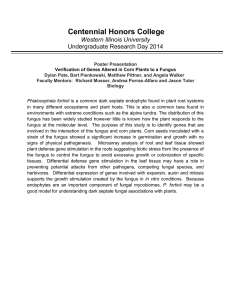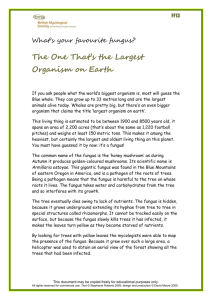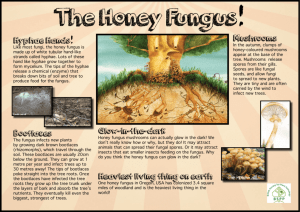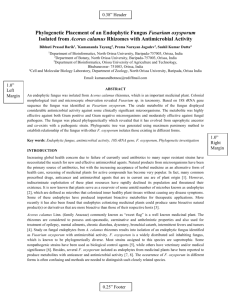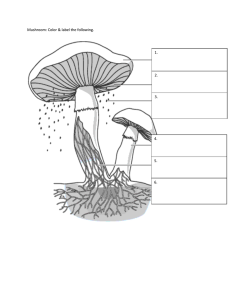Muscodor sutura with volatile antibiotic activities Hassan, Brad Geary, & Joe Sears
advertisement
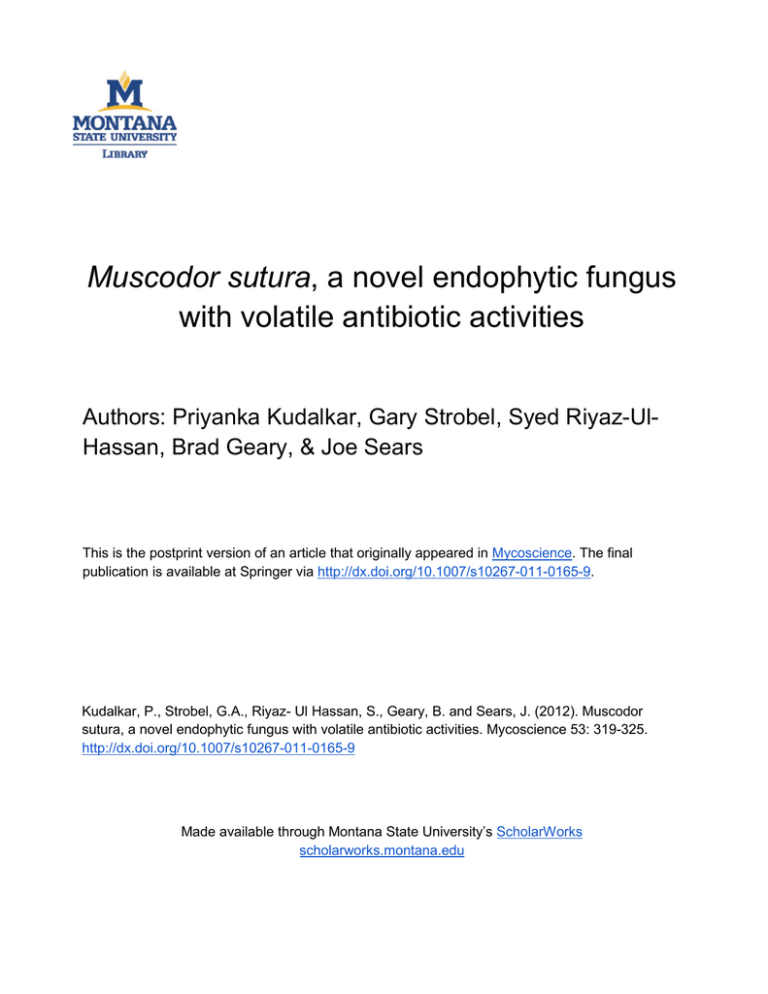
Muscodor sutura, a novel endophytic fungus with volatile antibiotic activities Authors: Priyanka Kudalkar, Gary Strobel, Syed Riyaz-UlHassan, Brad Geary, & Joe Sears This is the postprint version of an article that originally appeared in Mycoscience. The final publication is available at Springer via http://dx.doi.org/10.1007/s10267-011-0165-9. Kudalkar, P., Strobel, G.A., Riyaz- Ul Hassan, S., Geary, B. and Sears, J. (2012). Muscodor sutura, a novel endophytic fungus with volatile antibiotic activities. Mycoscience 53: 319-325. http://dx.doi.org/10.1007/s10267-011-0165-9 Made available through Montana State University’s ScholarWorks scholarworks.montana.edu Muscodor sutura, a novel endophytic fungus with volatile antibiotic activities Priyanka Kudalkar, Gary Strobel, Syed Riyaz-Ul-Hassan, Brad Geary, Joe Sears P. Kudalkar, G. Strobel, S. Riyaz-Ul-Hassan: Department of Plant Sciences & Plant Pathology, Montana State University, Bozeman, MT 59717, USA B. Geary: Department of Plant and Wildlife Sciences, Brigham Young University, Provo, UT 84602, USA J. Sears: Center for Lab Services/RJ Lee Group, 2710 North 20th Ave., Pasco, WA 99301, USA Abstract Muscodor sutura is described as a novel species that is also an endophyte of Prestonia trifidi. Uniquely, this fungus produces a reddish pigment, on potato dextrose agar (PDA), when grown in the dark. In addition, the organism makes some volatile organic compounds that have not been previously reported from this genus, namely, thujopsene, chamigrene, isocaryophyllene, and butanoic acid, 2-methyl. These and other volatile compounds in the mixture possess wide-spectrum antifungal activity and no observable antibacterial activity. Most unusually, on PDA, the newly developing hyphae of this fungus grow in a perfect stitching pattern, in and out of the agar surface. The partial ITS–DNA sequence of this organism is identical to that of Muscodor vitigenus but it differs from all other Muscodor spp. Justification for a new species, as Muscodor sutura, is collectively based on morphological, cultural, chemical, and bioactivity properties. Endophytic microorganisms are a rich source of natural products displaying a broad spectrum of biological activities (Strobel and Daisy 2003). They exist in association with the living tissues of plants and cause no apparent symptoms or signs of their presence (Bacon and White 2000). Interestingly, because of the ecological niche of endophytes, they have to be metabolically active to counter the defense mechanisms of the plant and they must be able to be competitive with other microbes (Zhang et al. 2006). Thus, it seems that the recovery of endophytes with a high degree of diversity and some novelty might be related to the biology of the host plant. Areas of the world possessing high plant biodiversity are found in tropical and temperate rainforest regions, and thus plants in these areas seem to possess a high diversity of endophytes (Strobel 2003). In some plants, endophytic fungi may have an influence on the ability of the plant to function in its environment. For instance, the thermotolerance of plants of plants growing in geothermal soils may be related to the endophytes associ-ated with them (Redman et al. 2002). These endophytes somehow enable the plants to withstand the high-temper-ature conditions present in the soil. Endophytes may also influence the structure of plant communities by affecting colonization, competition, coexistence, and soil nutrient dynamics (Clay and Holah 1999). In still other cases, herbaceous plants and grasses exhibit the presence of dominant endophytes that produce toxic alkaloids which have the potential of poisoning herbivores (Braun et al. 2003). In woody plants, endophytes may also function in specific defense roles to diminish or avoid pathogen dam-age to them (Strobel 2003). Overall, it seems that the biology and biochemistry of endophytes is a novel bur-geoning field, with a myriad of plants, microbes, and eventual ecological outcomes. Because endophytes in only a few host plants have been studied, it appears that there are abundant opportunities to find new organisms, host associations, and novel natural products. In this article is described the novel endophytic fungus designated Muscodor sutura-CA-22D isolated from the medicinal plant Prestonia trifida. The composition of its volatile organic compounds (VOCs) is presented with emphasis on their antimicrobial activities and identification by gas chromatography/mass spectrometry (GC/MS). As the fungus is novel, its morphological and physiological characteristics are also featured along with the manner in which it differs from related species. Small twigs of the medicinal plant Prestonia trifida, belonging to the family Apocynaceae, were obtained from the Columbian tropical Pacific rainforest at N 05°370 44400 , W 7 7°250 16200 , in November 2009. The endophytes from the plant were isolated by previously described methods (Worapong et al. 2001; Ezra et al. 2004). Briefly, the twigs were cut into pieces 1–2 cm long and surface treated thoroughly with 90% ethanol. The external tissues were removed, and small pieces of the internal tissue were plated on standard Petri plates containing water agar and glycerol–arginine agar and incubated at 23°C for 20 days. Plant tissues were also placed on potato dextrose agar (PDA) plates containing a 7-day-old M. albus culture. Thus, this fungus was used in a screening technique that would permit only Muscodor spp. and related fungi to grow (Ezra et al. 2004). Fungal hyphae growing out of the plant tissues were hyphal tipped and transferred to potato dextrose agar (PDA) plates as pure cultures. Fungal culture CA-22D was resistant to the VOCs of M. albus, thus facilitating its rapid selective isolation. The endophyte was stored in cryo-vials containing 15% glycerol and fungal colonized barley seeds at -70°. All the media components were obtained from Difco, USA. The VOCs of CA-22D were tested for antimicrobial activities by following the protocols developed by Strobel et al. (2001). Briefly, CA-22D was grown on the half-moon of PDA in a standard Petri dish in which a 2-cm-wide strip of agar was removed in the middle of the plate. The fungus was incubated at 23°C for 7 days or as mentioned otherwise for the optimum production of VOCs. The test organisms were inoculated on the other half and the plates were wrapped with a piece Parafilm and incubated again for 1–5 days. The growth of the test organisms were recorded as already described for general bioactivity testing. All test organisms were subjected to viability assays by transferring the inoculum plugs to fresh solid media after 2 and 4 days exposure to the VOCs. Viability was determined via observation of growth within 5 days of the transfer to PDA plates. Bacteria and yeasts were simply streaked and visually estimated as developing growth or no growth as compared to control cultures. Analyses of gases produced by CA-22D grown for 7 days at 23°C on PDA were carried out according to the protocols described earlier (Strobel et al. 2001). A baked ‘‘solid-phase micro-extraction’’ syringe (Supelco, St. Louis, MO, USA) consisting of 50/30 divinylbenzene/ carboxen on polydimethylsiloxane on a stable flex fiber was exposed for 5 min to the vapor phase present over the head space of the grown culture. The syringe was inserted into the splitless injection port of a Hewlett Packard 6890 gas chromatograph containing a 30 m 9 0.25 mm I.D. ZB wax capillary column with a film thickness of 0.50 lm. The column was subjected to the following thermal program: 30°C for 2 min, increased to 220°C a t5°C min-1. Ultrahigh purity helium was used as a carrier gas with an initial column head pressure of 50 kPa. The fiber was conditioned at 240°C for 20 min under a flow of helium gas before trapping the volatiles. A 30-s injection time was used to introduce the sample fiber into the GC. The gas chromatograph was interfaced to a Hewlett Packard 5973 mass selective detector (mass spectrometer) operating at unit resolution. The MS was scanned at a rate of 2.5 scans per second over a mass range of 35–360 amu. Data acquisition and data processing were performed on the Hewlett Packard ChemStation software system. Controls consisting of uninoculated PDA Petri plates were used to subtract compounds contributed by the medium. The compounds produced by CA-22D were tentatively identified through library comparison with the National Institute of Standards and Technology (NIST) database; hence, all chemical compounds described in this report use the NIST database chemical terminology. Final confirmatory identification was made for many compounds with authentic standards obtained from Sigma/Aldrich by comparing the GC/MS data of the standards, with GC/MS data of the fungal products, and these are indicated in the table. Other compounds listed were tentatively identified strictly on the basis of their high-quality match (70% or better) with the NIST data base compounds. Scanning electron microscopy (SEM) was performed on CA-22D to acquire morphological data and compare these with comparable information published on other genera of Muscodor. The fungus was grown on c-irradiated carnation leaves for 3 weeks, and then the samples were slowly dehydrated in ethanol, critically point dried, coated with gold, and examined with an FEI XL30 SEM–FEG with high vacuum mode using an Everhart–Thornley detector (Banerjee et al. 2010). The VOCs of CA-22D were tested for antimicrobial activities by following the protocols developed by Strobel et al. (2001). Briefly, CA-22D was grown on the half-moon of PDA in a standard Petri dish from which a 2-cm-wide strip of agar was removed in the middle of the plate. The fungus was incubated at 23°C for 7 days or as mentioned Fig. 1 a Scanning electron micrograph (SEM) of the stitchlike hyphal growth of Muscodor sutura at the front of the fungal colony on the surface of potato dextrose agar (PDA). b Ropylike growth of the mycelium of M. sutura. c Nondescript hyphal projections from M. sutura otherwise for the optimum production of VOCs. The test organisms were inoculated on the other half, and the plates were wrapped with a piece of Parafilm and incubated again for 24 h to 5 days. The growth of the test organisms were recorded as already described for the general bioactivity testing. All test organisms were subjected to viability assays by transferring the inoculum plugs to fresh solid media after 2 and 4 days exposure to the VOCs. Viability was determined via observation of growth within 5 days of the transfer to PDA plates. Bacteria and yeasts were simply streaked and visually estimated as developing growth or no growth as compared to control cultures. Scanning electron microscopy was performed for CA-22D to acquire morphological data and compare these with comparable information published on other genera of Muscodor. The fungus was grown on c-irradiated carnation leaves for 3 weeks, and then the samples were slowly dehydrated in ethanol, critically point dried, coated with gold, and examined with an FEI XL30 SEM–FEG with high vacuum mode using an Everhart–Thornley detector (Banerjee et al. 2010). Phylogenetic analysis of CA22-D was carried out by the acquisition of the ITS-5.8 S ribosomal gene sequence. The fungus was grown on PDA for 7 days on PDA, and DNA Table 1 Antimicrobial activity of the volatile organic compounds (VOCs) produced by Muscodor sutura reagents for sequencing were from Applied Biosystems, USA. The amplified products were sequenced and aligned with the sequences in the GenBank by the BLASTN program (Altschul et al. 1997) to ascertain the sequence homology with closely related organisms. The sequence data for this organism are deposited in GenBank as JF 938595. Test organism Percent (%) inhibition of 8-day-old culture (2 days exposure) Viability (alive or dead after 2 or 4 days exposure) Aspergillus fumigatus 100 No Botrytis cinerea 100 No Colletrotrichum lagenarium 100 No Ceratocystis ulmi 100 No Cercospora beticola 100 No Fusarium solani 58.0 Yes Geotrichum candidum 100 No Mycospharella fijiensis 100 No Phythophthora cinnamomi 100 No Phytophthora palmivora 100 No Pythium ultimum 100 No Rhizoctonia solani 100 No Sclerotinia sclerotiorum 100 No Fungus consociates cum planta medicinali Prestonia trifida (Apocynaceae). Fungus colonia patesco tendo lux lucis pre se ferre niveus mycelium cretum in perficio ambitus vultus. Talis colonia creta roseo ut locus in atrum. Lusum vel alius fructus compages es absentis. Hyphae (0.8–2.00 lm) cretae in penitus texo ratio per varius ligamen quod alius hyphal ut exertus videor in mycelii superficies. Fungor produco produxi productum exigo vieo-amo-exemplum discrepo convenienter in amplitudo (39.13–3.26 lm) ut cretscens in PDA. Trichoderma viridae 41.8 Yes MycoBank No. 561540 Verticillium dahliae 100 No Escherichia coli 0 Yes Bacillus subtilis 0 Yes Candida albicans 0 Yes Saccharomyces cerevisiae Inhibited No templates were prepared by using the Prepman Ultra Sample Preparation Reagent (Applied Biosystems, USA) according to the manufacturer’s guidelines. The ITS regions of the fungus were amplified with the universal ITS primers, ITS1 (50 -TCCGTAGGTGAACCTGCGG-30 ) and ITS4 (50-TCCTCCGCTTATTGATATGC-30) using polymerase chain reaction (PCR) (White et al. 1990). The PCR conditions used were as follows: initial denaturation at 94°C for 3 min followed by 30 cycles of 94°C for 15 s, 50°C for 30 s, 72°C for 45 s, and a final extension at 72°C for 5 min. The 50-ll reaction mixture contained 19 PCR buffer, 200 lM each dNTP, 1.5 mM MgCl2, 10 pmol each primer, 1–5 ng DNA, and 2.5 U Taq DNA polymerase. The amplified product (5 ll) was visualized on 1% (w/v) agarose gel to confirm the presence of a single amplified band. The amplified products were purified by Amicon Ultra columns (Millipore, USA), and 40–60 ng was used in a 10-ll sequencing reaction using the Big Dye Terminator sequencing kit (v. 3.1). The forward or the reverse primer (3.2 pmol) was used in the cycle sequencing reaction. Twenty cycles of 96°C for 10 s, 50°C for 5 s, and 60°C for 4 min were performed and the extension products were purified by ethanol precipitation, dissolved in 15 ll HiDi Formamide, incubated at 95°C for 1 min. and loaded on an ABI Prism 377 Genetic Analyzer (Perkin-Elmer, USA) for sequencing. All the Muscodor sutura Kudalkar, Strobel and Hassan sp. nov. Fig. 1c Holotype: Deposited as a specimen on autoclaved stem material at MSUB as 2380. It is also deposited in the living mycological collection of Montana State University as Acquisition No. 2380. Etymology: The species is named sutura, derived from the Latin word that means ‘‘sutures’’ or ‘‘stitches.’’ A consistently varying pattern of stitches is observed when the fungus is growing on the surface of PDA (Fig. 1a). The fungus, in nature, is associated with the medicinal plant Prestonia trifida (Apocyanaceae). Fungal colonies exposed to direct light exhibit white mycelia growing in a perfectly circular shape. Such colonies develop a pinkish tinge after 2 days when placed in the dark. Spores or other fruiting structures are absent. Hyphae (0.8–2.00 lm) grow in an inner woven manner with various stringy and other hyphal projections (extracellular matrix materials) appearing on hyphal surfaces (Fig. 1a, c). The fungus produces an exact ‘stitch-like-pattern’ varying consistently in size (39.13–3.26 lm) when growing on the surface of PDA (Fig. 1a). The mycelium growing on PDA covers a diameter of 4.7 cm in 30 days and produces a sweet wild-roselike odor at 10 days. The mycelia do penetrate the agar surface and it appears, however, that most of the mycelia produced are aerial. There is no evidence of spore production by this fungus on any medium or host material as manifested by efforts to induce sporulation on the leaves of the host plant or on c-irradiated carnation leaves. The fungus is in the group Fungi Imperfecti belonging to Mycelia Sterilia. The genus Muscodor was erected in 2001 with the discovery of Muscodor albus (Worapong et al. 2001). Generally, these organisms are all sterile, possess Table 2 A GC/MS air-space analysis of the volatile compounds produced by Muscodor sutura after 8 days incubation at 23°C on potato dextrose agar (PDA) using a solid-phase micro-extraction (SPME) fiber Retention time (min) Relative area Possible compound Quality Molecular mass (Da) Percent total relative area 1.59 40.15 Unknown 9 72 2.7 2.91 9.91 Acetonea 72 58 0.7 4.4 87.96 Propanoic acid, 2-methyl-, methyl estera 91 102 5.9 0.3 5.12 4.86 7-H-Dibenzo[b, g] carbazole, 7-methyl- 72 281 6.20 14.96 Butanoic acid, 2-methyl-,methyl ester, (?/-)-a 91 116 1 8.81 6.48 Unknown 56 282 0.4 18.68 7.49 Unknown 35 163 0.5 19.06 5.49 Unknown 38 136 0.4 20.32 9.24 Benzaldehydea 89 106 0.6 a 21.57 885.49 Propanoic acid, 2-methyl- 91 88 59.6 21.86 6.29 Bicyclo[7.2.0]undec-4-ene,4,11, 11-trimethyl-8-methylene-, [1r-(1r, 4z, 9s)] (or isocaryophyllene) 93 204 0.4 22.50 42.21 Thujopsenea 99 204 2.8 24.07 182.2 Butanoic acid, 2-methyl-a 87 102 12.3 24.43 5.36 Spiro[5.5]undec-2-ene,3,7,7-trimethyl11-methylene-, (-)- 99 204 0.4 25.51 5.75 Naphthalenea 93 128 0.4 29.00 6.31 Butylated hydroxytoluene 97 6.31 0.4 34.89 9.98 Unknown 56 204 0.7 38.00 40.67 Octadecanoic acid 98 284 2.7 38.79 12.31 Unknown 12 220 0.8 39.56 25.69 1,2-Benzenedicarboxylic acid, diisooctyl ester 87 390 1.7 39.60 40.44 25.15 40.44 Unknown Oleic acid 12 90 164 282 1.7 2.7 40.89 4.94 Unknown 14 318 0.3 41.91 5.64 Unknown 14 149 0.4 a Indicates that the retention time and mass spectrum of the compound matches that of the authentic standard ropy hyphae, produce biologically active VOCs, and all have been discovered as endophytes. Differences in the chemistry of the VOCs, growth habit, host preference, and ITS sequences have resulted in numerous other species in this genus being described (see Table 3). Molecular phylogeny of this organism was carried out by sequencing the ITS-5.8 S ribosomal gene of the fungus. The DNA sequence, thus obtained, showed a maximum homology of 100% with Muscodor vitigenus (Daisy et al. 2002), depicting that the fungus belongs to the genus Muscodor (see Table 4). The region also showed high sequence similarity ([94%) with M. yucatanensis B110, M. fengyangenesis, and M. crispans B23 (with 73% coverage), respectively (Mitchell et al. 2008) (Table 4). In addition to its relationship with the different Muscodor species, a BLAST search showed a 90% sequence similarity to several Xylaria spp. (Table 4). A panel of fungal and bacterial pathogens where grown in the presence of the VOCs produced by M. sutura (10-day-old culture) to evaluate their antimicrobial activities (Table 1). After a 2-day exposure, the VOCs inhibited 13 of the 15 test fungi completely. The only 2 fungi that were not completely inhibited were Trichoderma viridae and Fusarium solani, showing about 42% and 58% growth inhibition, respectively (Table 1). Test organisms that were completely inhibited by the VOCs were also not viable after an exposure of 2 and 4 days, with the exception of Aspergillus fumigatus. Among the two yeasts, Candida albicans and Saccharomyces cerevisiae, the former was not inhibited whereas the latter was inhibited and killed. The fungal VOCs were not active against the bacteria tested including both a gram-negative and gram-positive bacterium, i.e., Escherichia coli and Bacillus subtilis, respectively. M. sutura produced optimum VOCs after 8 days of growth; however, once the culture grew older, the percent growth inhibition for some of the pathogens, viz. Cercospora beticola, Rhizoctonia solani, and Geotrichum candidum started to decline (data not shown). Table 3 Comparison of Muscodor sutura with related Muscodor spp. Character M. sutura M. albus M. vitigenus M. cinnamomi M. crispans M. fengyangensis Pigment production Reddish in the dark None None Pale orange in light Reddish in the light Yellowish pigment Hyphal growth at colony front A suture-like pattern on PDA with new growth Straight hyphae Straight hyphae Straight hyphae Heavily wavy newly growing hyphae Straight hyphae Spores None None None None None None Mycelial growth Rope-like nondescript extracellular bodies Rope-like Rope-like Rope-like with cauliflower-like bodies Rope-like with cauliflowerlike bodies Rope-like with coiled hyphae Major VOCs Propanoic acid, 2-methyl, thujopsene Propanoic acid, 2-methyl, naphthalene and azulene derivatives Naphthalene solely Propanoic acid, 2 methyl, methyl ester, b-humulene Propanoic acid, 2-methyl and many esters Azulene and naphthalene derivatives and many others Bioactivity Antifungal Antifungal/antibacterial Anti-insect Not studied Antifungal/ antibacterial Antifungal/ antibacterial VOC analyses were repeated at least three times. However, comparative data (for VOCs) on M. fengyangensis and M. cinnamomi were taken from the literature All VOC studies were done in the author’s laboratory over the course of several years, and the conditions were identical Table 4 A summary of the BLAST search (Altschul et al. 1997) for the homology analysis of ITS-5.8 S ribosomal gene sequence Muscodor sutura CA22-D Organism GenBank acc. no. Query coverage (%) E value Muscodor sutura CA22-D JF938595 – – – Muscodor vitigenus P15 AY100022 100 0.0 100 Muscodor yucatanensis B110 Muscodor albus FJ917287 AY927993 100 100 0.0 0.0 97 89 Muscodor albus CMU44 HM473081 100 0.0 89 Muscodor albus TP 21 AY527045 100 0.0 89 Muscodor cinnanomi CMU-Cib GQ848369 100 0.0 89 Muscodor albus GP 115 AY527047 99 0.0 94 Anthostomella proteae CBS:110127 EU552101 100 1e-170 87 Xylaria berteri 90112623 GU324749 75 6e-148 90 Xylaria curta SGLAf41 EU715614 75 3e-146 90 Xylaria enteroleuca AM084368 75 3e-146 90 Muscodor crispans B-23 EU195297 73 1e-179 95 Muscodor fengyangensis ZJLQ070 HM034853 68 2e-163 94 The VOCs produced by the 8-day-old culture of M. sutura were analyzed by GC/MS and preliminarily identified by comparison with MS data of reference compounds listed in the NIST database and in some cases with authentic standards. Propionic acid, 2-methyl was the most abundant compound on the basis of total integrated peak area of the GC elution profile, constituting around 65% of all the identified compounds. Butanoic acid, 2-methyl was the next most abundant VOC, constituting about 13% of the total. The most unusual compounds produced by Sequence similarity (%) M. sutura were thujopsene (3.1%), isocaryophyllene (0.5%), chamigrene (0.4%), oleic acid (3%), naphthalene (0.4%), and 1,2-benzenedicarboxylic acid, diisooctyl ester (1.9%) (Table 2). Muscodor sutura is introduced as a novel species of Muscodor based on differences in colony and hyphal morphologies as well as VOC production, biological activities, and ITS sequence data. The organism behaved as other members of this group in that it produced a whitishropy mycelium and no spore production on any substrate or medium tested (Strobel et al. 2001). Some of the molecular-structural features of this organism are similar to other species in this group, including ITS sequences identical to M. vitigenus, but having some differences from all other Muscodor ITS sequences (Table 4) (Daisy et al. 2002). Its pinkish pigment production was similar to that of M. crispans, but the pigment is made under dark conditions (Table 3) (Mitchell et al. 2008). In contrast, most Muscodor spp. have no pigmentation (Table 3). The most unique aspect of the biology of M. sutura is its growth behavior on PDA at the leading edge of colony development. Individual hyphae as well as hyphal strands grow in and out of the agar surface making an even suture (stitching like) pattern on the surface (Fig. 1a). In this manner, the mycelium is firmly attached to the agar surface, in contrast to other species of Muscodor (Table 3). In addition, M. sutura produces many nondescript extracellular bodies that are attached to the mycelium, but none of these are similar to those made by M. crispans and M. cinnamomi (Fig. 1c) (Table 3). Also, although many isolates of Muscodor make propanoic acid, 2-methyl and its esters, M. sutura is the first member of this group shown to produce thujopsene and isocaryophyllene (Table 3). Finally, the biological activity of M. sutura is unique in that it seems not to have either inhibitory or killing effects on the test bacteria, which is in contrast to many of the other species of this organism including M. albus, M. fengyangensis, and M. crispans (Mitchell et al. 2010) (Table 1). Acknowledgments The authors appreciate the financial assistance from NSF and DoE grants to carry out this work. The BOYSCAST program of India granted a 1-year fellowship to S.Y.U.H. to study and work at MSU. The authors are grateful to Mr. Percy Nunez of Cusco, Peru, for generously identifying plant materials and providing the Latin description of this organism. References Altschul SF, Madden TL, Schaffer AA, Zhang J, Zhang Z, Miller W, Lipman DJ (1997) Gapped BLAST and PSI-BLAST: a new generation of protein database search programs. Nucleic Acids Res 25:3389–3402 Bacon CW, White JF (2000) Microbial endophytes. Dekker, New York Banerjee D, Strobel G, Geary B, Sears J, Ezra D, Liarzi O, Coombs J (2010) Muscodor albus strain GBA, an endophytic fungus of Ginkgo biloba from the United States of America, produces volatile antimicrobials. Mycology 1:179–186 Braun K, Romero J, Liddell C, Creamer R (2003) Production of swainsonine by fungal endophytes of locoweed. Mycol Res 107:980–988 Clay K, Holah J (1999) Fungal endophyte symbiosis and plant diversity in successional fields. Science 285:1742–1744 Daisy BH, Strobel GA, Castillo U, Ezra D, Sears J, Weaver DK, Runyon JB (2002) Naphthalene, an insect repellent, is produced by Muscodor vitigenus, a novel endophytic fungus. Microbiology 148:3737–3741 Ezra D, Hess WM, Strobel GA (2004) New endophytic isolates of Muscodor albus, a volatile-antibiotic-producing fungus. Microbiology 12:4023–4031 Mitchell A, Strobel G, Hess W, Vargas P, Ezra D (2008) Muscodor crispans, a novel endophyte from Ananas ananassoides in the Bolivian Amazon. Fung Divers 31:37–43 Mitchell AM, Strobel GA, Moore E, Robinson R, Sears J (2010) Volatile antimicrobials from Muscodor crispans, a novel endophytic fungus. Microbiology 156:270–277 Redman RS, Sheehan KB, Stout RG, Rodriguez RJ, Henson JM (2002) Thermotolerance generated by plant/fungal symbiosis. Science 298:1581 Strobel GA (2003) Endophytes as a source of bioactive products. Microbes Infect 6:535–544 Strobel G, Daisy B (2003) Bioprospecting for microbial endophytes and their natural products. Microbiol Mol Biol Rev 4:491–502 Strobel GA, Dirske E, Sears J, Markworth C (2001) Volatile antimicrobials from Muscodor albus, a novel endophytic fungus. Microbiology 147:2943–2950 White TJ, Bruns T, Taylor JW (1990) Amplification of direct sequencing of fungal ribosomal RNA genes for phylogenetics. In: Innis MA, Gelfand DH, Sninsky JJ, White TJ (eds) PCR protocols: a guide to methods and applications. Academic Press, San Diego, pp 315–324 Worapong J, Strobel GA, Daisy BH, Castillo U, Baird G, Hess WM (2001) Muscodor albus anam. gen. et sp. nov., an endophyte from Cinnamomum zeylanicum. Mycotaxon 79:67–79 Zhang HW, Yong CS, Ren XT (2006) Biology and chemistry of endophytes. Nat Prod Rep 23:753–771
